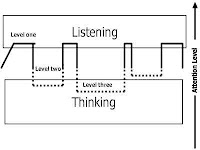"One of the greatest misconceptions about music mixers (especially the great ones) is that they mix at high volume levels. Some do, and at excruciatingly loud levels as well, but most mixers find that they get better balances that translate well to the real listening world by monitoring at conversation level (79dB SPL) or even lower.
High SPL levels for long periods of time are generally not recommended for the following reasons:
1) First the obvious one, exposure to high volume levels over long periods of time my cause long-term physical damage.
2) High volume levels for long periods of time will not only cause the onset of ear fatigue, but physical fatigue as well. This means that you might effectively only be able to work six hours instead of the normal eight (or ten or twelve) that’s possible if listening at lower levels.
3) The ear has different frequency response curves at high volume levels that overcompensate on both the high and low frequencies. This means that your high volume mix will generally sound pretty limp when it’s played at softer levels.
4) Balances tend to blur at higher levels. What sounds great at higher levels won’t necessarily sound that way when played softer. However, balances that are made at softer levels always work when played louder.
Now this isn’t to say that all mixing should be done at the same level and everything should be played quietly. In fact, music mixers (as opposed to film mixing, which always uses one constant level) tend to work at a variety of levels; up loud for a minute to check the low end, and moderate while checking the EQ and effects. But the final balances usually will be done quietly.
Sometimes, the only way that you can check how much low-end is on a mix is to turn it up to a moderately loud level for a brief period, so don’t be afraid to do that if needed. Just remember that keeping it up loud for long periods of time probably won’t help your mix translate to other systems too well.
Listening On Several Speaker Systems
If you don’t have an alternate monitor system yet, then what are you waiting for? Most veteran mixers use at least a couple of systems to get a feel for how everything sounds - the main system where the mixer does all of the major listening work, and an alternate system for a different perspective.
The alternate speaker is used simply as a balance check to make sure that one of the instruments isn’t either too loud or too soft in the mix. Also, one of the arts of mix balance is getting the kick drum and bass guitar to speak well on a small system, which is why an alternative monitor system is so important.
The second set of monitors doesn’t have to be great. In fact, the crappier they are, the better. Even a set of ten dollar computer speakers can do. The idea is to have a second set that will give you an idea of what things sound like in that world, since unfortunately, there are a lot more people listening on crappy monitors than good ones these days."
To read additional excerpts from this and my other books, go to bobbyowsinski.com.
Also, check out the Audio Mixing Bootcamp video course from Lynda.com.
To read additional excerpts from this and my other books, go to bobbyowsinski.com.
Also, check out the Audio Mixing Bootcamp video course from Lynda.com.
----------------------------------
Help support this blog. Any purchases made through our Amazon links help support this website with no cost to you.You should follow me on Twitter for daily news and updates on production and the music business.
Don't forget to check out my Music 3.0 blog for tips and tricks on navigating social media and the new music business.



3 comments:
I have discovered that mixing too quiet, as is sometimes required in my apartment, results in a noisy, congested mix where it is hard to hear individual instruments. Sounds GREAT when listened to at 'candle light and dinner' levels, but sounds like 'turn it down!' at levels louder than it was mixed.
Maybe if i were to mix at loud levels, then when played at low levels it might sound like 'turn it up!'. Does this make any sense?
Cheers,
Hal,
Vancouver
Yes, that's the trick. You listen at louder levels to balance the low end, then go to quieter level for most of your mixing, then finish at the much lower level for final balance checks.
Yes, that's the trick. You listen at louder levels to balance the low end, then go to quieter level for most of your mixing, then finish at the much lower level for final balance checks.
Post a Comment